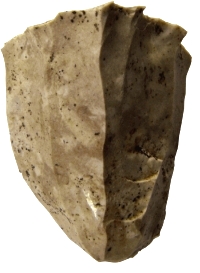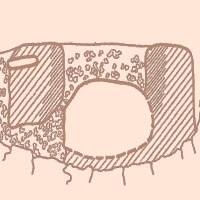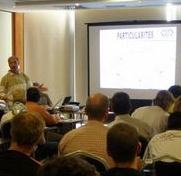 |
Description of project
tasks
 Study of the Stone Age flint processing techniques used
in present-day Latvia (c. 10,000-1800 BC), in the course of
which blades for tool-making were obtained from flint cores, with
a focus on the transfer of this technical knowledge in the context of
Northern Europe. Latvian and Norwegian specialists will collaborate to
obtain and analyse morphological data from flint cores and blades.
Bearing in mind that neither Norway nor Latvia has sources of
high-quality, easily workable flint, a question of particular interest
is the adaptation of flint processing technologies in antiquity to
local raw materials of inferior quality. Study of the Stone Age flint processing techniques used
in present-day Latvia (c. 10,000-1800 BC), in the course of
which blades for tool-making were obtained from flint cores, with
a focus on the transfer of this technical knowledge in the context of
Northern Europe. Latvian and Norwegian specialists will collaborate to
obtain and analyse morphological data from flint cores and blades.
Bearing in mind that neither Norway nor Latvia has sources of
high-quality, easily workable flint, a question of particular interest
is the adaptation of flint processing technologies in antiquity to
local raw materials of inferior quality.
|
 Systematisation
and analysis of previously obtained archaeological and historical evidence of iron production in present-day
Latvia during the Iron Age (2nd-12th cent.), Middle Ages
(13th-15th cent.) and early modern period (16th-18th cent.)
in order to trace the development and transfer of
iron smelting
technology. Attention is focussed on furnaces,
examining their stuctural and functional characteristics, and on
the location of iron production sites. Systematisation
and analysis of previously obtained archaeological and historical evidence of iron production in present-day
Latvia during the Iron Age (2nd-12th cent.), Middle Ages
(13th-15th cent.) and early modern period (16th-18th cent.)
in order to trace the development and transfer of
iron smelting
technology. Attention is focussed on furnaces,
examining their stuctural and functional characteristics, and on
the location of iron production sites.
|
 There is a special focus
within the project on the 16th-18th
century ironworks in the Duchy of Courland and Semigallia (the
western and
southern part of present-day Latvia).
Bringing together the available historical data on manufactories and
iron circulation, as well as the small amount of archaeological
evidence obtained in the course of survey work on ironworks sites, a
geospatial database is created, bringing together data on these early
modern sites, which serves as a basis for assessing the present state
of knowledge and planning further research. There is a special focus
within the project on the 16th-18th
century ironworks in the Duchy of Courland and Semigallia (the
western and
southern part of present-day Latvia).
Bringing together the available historical data on manufactories and
iron circulation, as well as the small amount of archaeological
evidence obtained in the course of survey work on ironworks sites, a
geospatial database is created, bringing together data on these early
modern sites, which serves as a basis for assessing the present state
of knowledge and planning further research.
|
 The
project includes fieldwork
intended to provide new archaeological data specifically about the
ironworks of the Duchy of Courland and Semigallia.
In spring 2016 these sites are systematically surveyed and documented,
followed by major excavation in summery 2016 at one such site, with the
primary aim of obtaining more precise information about iron production
technologies and how they developed. In addition to experts from Latvia
and Norway, students of the Faculty of History and Philosophy of the
University of Latvia take part in the excavation, gaining experience in
archaeological fieldwork. The data on ironworks sites is submitted to
the State Inspection for Heritage Protection. The
project includes fieldwork
intended to provide new archaeological data specifically about the
ironworks of the Duchy of Courland and Semigallia.
In spring 2016 these sites are systematically surveyed and documented,
followed by major excavation in summery 2016 at one such site, with the
primary aim of obtaining more precise information about iron production
technologies and how they developed. In addition to experts from Latvia
and Norway, students of the Faculty of History and Philosophy of the
University of Latvia take part in the excavation, gaining experience in
archaeological fieldwork. The data on ironworks sites is submitted to
the State Inspection for Heritage Protection.
|
 Norwegian
specialists carry out metallographic, petrographic, chemical and other analyses, in order to characterise
samples of ore, slag and iron recovered during previous research at
iron production sites and in the frame of this project. This data permits reconstruction of
iron production processes and technologies, and assessment of the
quality of the ore and the iron produced. Norwegian
specialists carry out metallographic, petrographic, chemical and other analyses, in order to characterise
samples of ore, slag and iron recovered during previous research at
iron production sites and in the frame of this project. This data permits reconstruction of
iron production processes and technologies, and assessment of the
quality of the ore and the iron produced.
|
 Reconstruction of a 10th century iron
smelting furnace at the Seaside Open-Air Museum in Ventspils in
the summer of 2016, based on furnace remains excavated at Asote
Hill-Fort. The furnace
reconstruction is used for iron production, with the aim of obtaining a
clearer insight into the state of iron production technology in the
later part of the Iron Age. Reconstruction of a 10th century iron
smelting furnace at the Seaside Open-Air Museum in Ventspils in
the summer of 2016, based on furnace remains excavated at Asote
Hill-Fort. The furnace
reconstruction is used for iron production, with the aim of obtaining a
clearer insight into the state of iron production technology in the
later part of the Iron Age. |
 A
joint workshop in
Riga in autumn 2016. The ideas
developed in the frame of the project concerning flint processing and
iron production technology are presented in two parallel sessions, with
a closing session to discuss questions relating to the transfer of
technology in earlier times, specifically with regard to mineral
resources. A
joint workshop in
Riga in autumn 2016. The ideas
developed in the frame of the project concerning flint processing and
iron production technology are presented in two parallel sessions, with
a closing session to discuss questions relating to the transfer of
technology in earlier times, specifically with regard to mineral
resources. |
 The
most important outcome of the project: articles in international and national
scientific publications,
prepared jointly by the Latvian and Norwegian experts, reflecting
the results and major findings of the project. The
most important outcome of the project: articles in international and national
scientific publications,
prepared jointly by the Latvian and Norwegian experts, reflecting
the results and major findings of the project. |
|
 LV | EN
LV | EN
